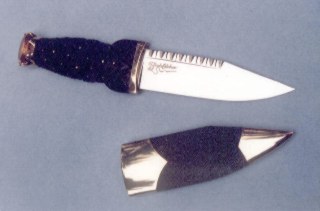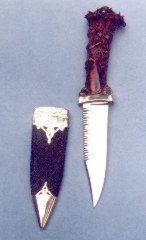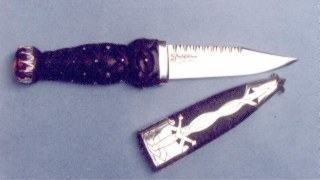The Sgian Dubh
What proper Cock of the North (Scottish Gentleman) would be caught in public without a suitable knife tucked in the top of his hose? None, I dare say. It was not always thus.
By Joe D. Huddleston
There is little that students of highland dress agree on about the sgian dubh, even its spelling. It is seen as skein dubh, sgian dhub, skene du, skean dhu and skhian dubh, and doubtless others. Phonetically, it is pronounced skein or skeen doo. The meaning, however, is clear: sgian means knife or dagger, dubh means black. There is some discussion about the meaning of black in this connotation. Some feel that black comes from the usual color of the handle of the little knife, but the great majority feel that it means secret, or hidden, as in the word blackmail. This is rooted in one of the prominent theories about the knife’s origin.

This theory contends that the sgian dubh evolved from the sgian achlais (ochles), the armpit dagger mentioned in connection with the Scots in the 17th and 18th centuries. This was a knife slightly larger than today’s sgian dubh that was carried in the upper sleeve of the jacket and drawn from the inside through the armhole, or possibly in the lining of the body of the jacket under the left arm; the references are unclear. I believe, but have no proof, that this is the same knife that a Scottish woman would have carried under the apron of her wrap-around “kilted” skirt, along with her purse. Just as with any man, a woman would have had to carry her own eating utensils. Mary MacGregor makes good use of one in the recent movie Rob Roy.
No knife still exists that can be identified as a sgian achlais, so that is no help. However, this does fit the description of a secret, or “black” knife. Courtesy of the day demanded that, when entering the home of a friend, no weapons could remain concealed. It is logical that when the sgian achlais was removed from its hiding place, the stocking top was a convenient place to display it, securely held by the garter.
A second theory holds that the sgian dubh evolved from the small skinning knife that was part of the typical set of hunting or gralloch knives. Some of these do exist. There is usually a butchering knife with a blade of 9-10 inches and a skinner with a blade of only 3 1/2-4 inches. These gralloch knives usually had antler handles, and so do not fit the term black in either color or carry. This theory does have two points in its favor, however. First, many early sgian dubhs are fitted with antler or horn handles. Secondly, the skinning and butchering of wild game after the successful hunt was usually undertaken by the upper-class hunter’s ghillie, literally “boy” in Gaelic, as in serving boy. The huntsman would not stoop to such work. It may have been a hangover of this attitude that had officers in the military regiments resist the carrying of sgian dubhs, as they were initially considered fit only for “ghillies and serving rascals.”

When the sgian dubh first began to be worn full-time in the stocking top is best revealed in portraits of men in kilts painted in the early to mid 1800’s. A portrait by Sir Henry Raeburn gives the first hint of the little knife’s appearance. His 1810-1812 painting of Colonel Alisdair Ranaldson MacDonell, 15th Chief of the MacDonells of Glengarry, that hangs in the National Portrait Gallery of Scotland shows him wearing what appears to be a sheath that holds two nested knives. The National Museum of Antiquities of Scotland has a similar sgian dubh in its collections.
Colonel MacDonell was the last of the great clan chiefs, in the sense that he always dressed in highland attire, and never went anywhere without his tail, or suite of attendants. He invented the Glengarry bonnet and became notorious for killing the famous Flora MacDonald’s grandson in a duel and for spending his clan into poverty. He was a friend of Sir Walter Scott and was the model for the character Fergus MacIvor in Scott’s novel Waverly.
Waverly was the first of a series of novels about the highlanders by Scott, that helped inspire the Scottish Romantic period. Written beginning in 1805, it centered on the Jacobite Rebellion of 1745-46 and was not much more distant in time from that rebellion than we are from World War II. In Waverly is a passage dealing with the sgian achlais. The hero, Edward Waverly, is speaking with his companion, a highland teenager, about a tavern keeper who is about to discover their true identity. Scott had an unusual way of writing the broad Scot’s dialect, so I have interpreted in italics:
“If his honor thought ta auld deevil Whig carle was a bit dangerous, she could easily provide for him, and teil ta wiser.”
If Waverly thought the old devil Whig commoner was a bit dangerous, I could easily provide for him, and none the wiser.
“How, and in what manner?”
“She ain sell,” replied Callum, “could wait for him a wee bit frae the toun, and kittle his quarters with she skene-occle.”
My own self, replied Callum, could wait for him a little way from the town, and “kittle his quarters” with my skene-occle.
“Skene-occle! What’s that?”
Callum unbuttoned his coat, raised his left arm, and, with an emphatic nod, pointed to the hilt of a small dirk, snugly deposited under it, in the lining of his jacket….
“Good God, Callum, would you take the man’s life?”
“Indeed,” answered the young desperado.
There is little reason to doubt that Scott had seen the sgian achlais in his early days, growing up a Scottish writer in the late 1700’s and with an abiding interest in the highlander.
That the little knife was not fully accepted by the upper classes is hinted at by the fact it is not worn by “that wee German Laddie,” King George IV, when he was painted in full highland regalia during his visit to Scotland in 1822. By the 1850’s, however the sgian dubh was universally worn.

The early sgian dubhs were often crudely made by local Scottish smiths. They usually had antler or horn handles and were mounted in brass, with a simple leather sheath. They were slightly larger than today’s sgian dubh, with blades ranging from 3 1/2 to 4 inches. The handles were full round, with little consideration given to how the knife would fit the anatomy of the wearer. As time went on and the sgian dubh was accepted as a full partner to the dirk, it began to be decorated in the same way as the dirk, and frequently made en suite with it, kept in the same fitted wooden case with its larger companion.
By now they were made, like the dirk, with carved ebony and occasionally ivory handles. The carving was normally of the simple basket-weave pattern that had become popular on the dirk, with silver pins at the corners of the carved panels. The handles were almost invariably black, flat on the back where they came in contact with the leg, and some had the owner’s crest or coat of arms mounted on them. Military sgian dubhs frequently had some form of the regimental insignia on them. Only rarely were the handles carved with the earlier style of Celtic knotwork that had been popular on the dirk in the 1600’s and 1700’s, usually when custom made en suite with a dirk with that early style carving. The pommels held mounts and stones to match the dirk, and the occasional matching sporran and plaid brooch.
The early blades frequently had a clipped point, a style that we now associate with the bowie knife. Some had the scalloped filework on the back of the blade that is common on all Scottish knives. As time went on, the blades were shortened slightly, running between 3 and 3 1/2 inches. The shape was altered to a spear point, and filework became universal. At least one sgian dubh is known that had a solid silver blade, useless for most chores beyond cleaning the fingernails. Some regimental sgian dubhs had blades etched with regimental symbols.
The early leather sheaths, like those on the early dirks, evolved into highly decorated pieces of art. They were reinforced with wood and fitted with silver throats and tips, pierced and engraved. While this makes for great bragging rights, it certainly has no practical purpose, as the sheath is hidden in the stocking while the sgian dubh is worn.
When Victoria became Queen of England in 1837, the Scottish romantic period began in earnest. For example, Balmoral Castle in the highlands, complete with tartan carpets, was her favorite summer residence. Lavish dirks and sgian dubhs reached their peak around the end of her reign in 1901 and continued until WWI ended such impractical romances. Sgian dubhs found themselves buried in the mud of the Somme and Neuve Chapelle. After the war the gaudy military dirks and sgian dubhs were largely gone, but the flamboyant period between the wars saw some very extravagant civilian sets made. One set, made in 1925 for the Prince of Wales and now in the Tower of London Royal Armories, was auctioned in 1987 for $403,333.
On the other hand, the tradition of the antler-handled dirk and sgian dubh returned in the 1800’s. Usually mounted in brass, they were, and still are, worn for informal day wear. Most have some type of brass or silver pommel decoration, and some have stones mounted.
The sgian dubh is not known to have ever been used in an act of violence, but it no doubt has been. Anyone who has ever worn one knows that the stocking-top carry is very convenient and fast to the hand. In 1931 a member of the House of Commons appeared at the door in full highland dress, and “Before being allowed to enter the Chamber, Mr. Ramsay had to leave his skean dhu behind him, as it was pointed out to him that it came under the category of lethal weapons, the possession of which is expressly forbidden inside the House.” A good rule, since in the U. S. Congress, members are known to have drawn pistols and bowie knives against each other on several occasions in the 1800’s.
Over time, several legends have grown up about the sgian dubh. One is that the stone mounted in its pommel is carefully weighed and placed to properly balance the knife for throwing, which is patently ridiculous to anyone who has ever thrown a knife. Another is that like the dirk and the Gurkha kukri, the sgian dubh is never to be drawn for trivial or mundane purposes and must taste blood before it can be resheathed, even if the user must nick his own finger.
Today, the sgian dubh has lost much of its glamour. The great majority are made in the Philippines, India or Hong Kong. Little attention is paid to the blade, and some blades are even made of nickel-plated brass. The handles are usually plastic fitted with nickel-plated pot-metal castings and holding plastic stones. Some are not even knives at all, but a plastic handle and sheath cast as one piece. At least this has some precedent–in the Victorian age one-piece dirks and sgian dubhs were made for young boys who couldn’t be trusted with a real knife. And, considering the recent laws passed in Britain against carrying knives, this may be the only way a Scot can support an honored tradition. The other alternative might be what was done by some members of kilted regiments–having the image of a sgian dubh tattooed on the leg.
However, here in the “Colonies,” the tradition is alive and well. Custom knifemakers still make the dirk and sgian dubh, and most states allow the carrying of any knife that is not concealed. As is often the case, the off-shore Scot is the most enthusiastic upholder of tradition.
AUTHOR’S NOTE: The author is indebted to several works by James D. Forman, principally his booklet The Scottish Dirk, as a resource. All knives made by Joe D. Huddleston, BladeCatcher Knives, 14129 93rd Ave. SE, Yelm, WA 98597, (360) 458-2361. Huddleston is decended from the MacDonells of Glengarry and proudly wears their kilt at knife shows and highland games. Prices of knives illustrated, $250 to $995. Photos by Huddleston.
This article originally appeared in The Highlander magazine / (800) 607-4410
Copyright (C) 1999 Oregon Knife Collectors Association. No part of this article may be reproduced without permission of the OKCA.
